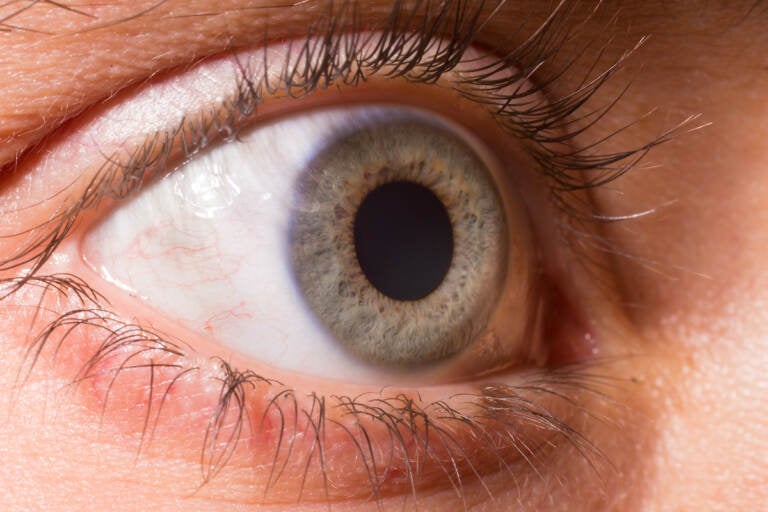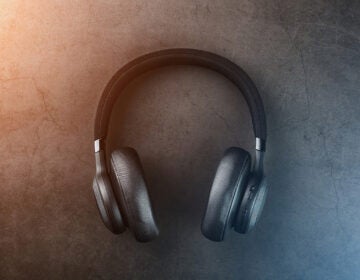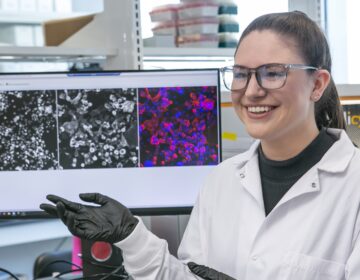How TikTok’s pupil test works, and what it tells us about love and attraction
A TikTok trend that claims to test if you’re really in love may have some real science behind it.
Listen 6:21
Close up on dilated pupil. (Courtesy of Big Stock Image)
This story is from The Pulse, a weekly health and science podcast.
Find it on Apple Podcasts, Spotify or wherever you get your podcasts.
The videos go like this: Someone uses their phone to zoom in on their eye, and then thinks hard about a crush, a love interest, or even their current partner. If their pupil dilates, then they’re really in love.
To Helen Fisher, biological anthropologist, senior researcher at the Kinsey Institute, and chief science adviser to the dating site Match.com, the interest in a test like this is only natural.
“Of course, we all do want to know whether somebody is attracted to us, and here’s another way of figuring it out,” she said. “I think this TikTok thing is quite ingenious.”
Fisher hadn’t seen the videos before, but she thinks they may be on to something. “It’s beautiful the way the body works, you know, it really is. There’s so many ways that we let the world know who we are without language.”
When we’re attracted to someone, Fisher said, it prompts a chemical rush that’s actually part of our fight or flight response.
“What’s going on is that when you’re thinking about somebody that you are in love with, that’s triggering activity of feelings in the limbic system in the middle of the head, that’s sending signals up to the hypothalamus, pumps out norepinephrine and epinephrine or adrenaline. And what the adrenaline does is it controls the iris muscle of the eye, and as that becomes activated, it pulls the pupil to become larger,” she said.
For human beings, love is a life-or-death issue. The region of our brain that produces feelings of romantic love is called the ventral tegmental area — VTA.
“This little brain region, the VTA, lies right next to the factory that orchestrates thirst and hunger,” said Fisher. “Thirst and hunger keep you alive today; romantic love drives you to form a partnership and send your DNA into tomorrow.”
She said it’s not clear why some pupils dilate and some don’t in these videos. It could be something to do with how peaceful your partnership is, or how long you’ve been together. But she’s interested in learning more.
“I think somebody should go do it,” said Fisher. “Take older people who reported they’re madly in love and see what happens to the pupils!”
Though a person’s dilated pupil can be a tell-tale sign of attraction, it’s a pretty subtle clue. Many other creatures seem to express their willingness to mate much more openly.
Subscribe to The Pulse
“For the rats, it’s ear wiggling and hopping and dancing to show that they are in that receptive window. For others, it’s changing colors, depending on the species. For others, it’s changing vocalizing, and so on,” said Nafissa Ismail, an associate professor of psychology at the University of Ottawa.
For many animals, Ismail said, there’s a short window in which the time is right for sex, so their signals tend to be more urgent.
“Often, reproduction is limited to a specific period during the year. They need to spread their genes before being attacked by a predator and find a female that is receptive … it needs to be pretty obvious that they are looking for a partner,” Ismail said.
Humans, on the other hand, can afford to be a bit more subtle. “We are luckily not limited to that, so we will copulate at other periods across the menstrual cycle that is not limited to ovulation,” Ismail said.
Pupil dilation may be a little more understated than a peacock’s display or a koala’s mating call, but it basically accomplishes the same thing, said Lynne Honey, an associate professor specializing in learning and behavior at MacEwan University in Edmonton, Alberta.
“There are studies that take a look at pupil dilation and demonstrate that faces with dilated pupils are perceived as more attractive,” Honey said. “So, we might not necessarily know consciously why that signal is important, but at an unconscious level we respond to it by finding those faces more appealing, and there’s a bunch of signals like that in humans, where you can’t even necessarily put your finger on it, but it’s still influencing our behavior.”
So really, we don’t need TikTok — we may not realize it consciously, but our brains perform the pupil test for us all the time.
WHYY is your source for fact-based, in-depth journalism and information. As a nonprofit organization, we rely on financial support from readers like you. Please give today.






